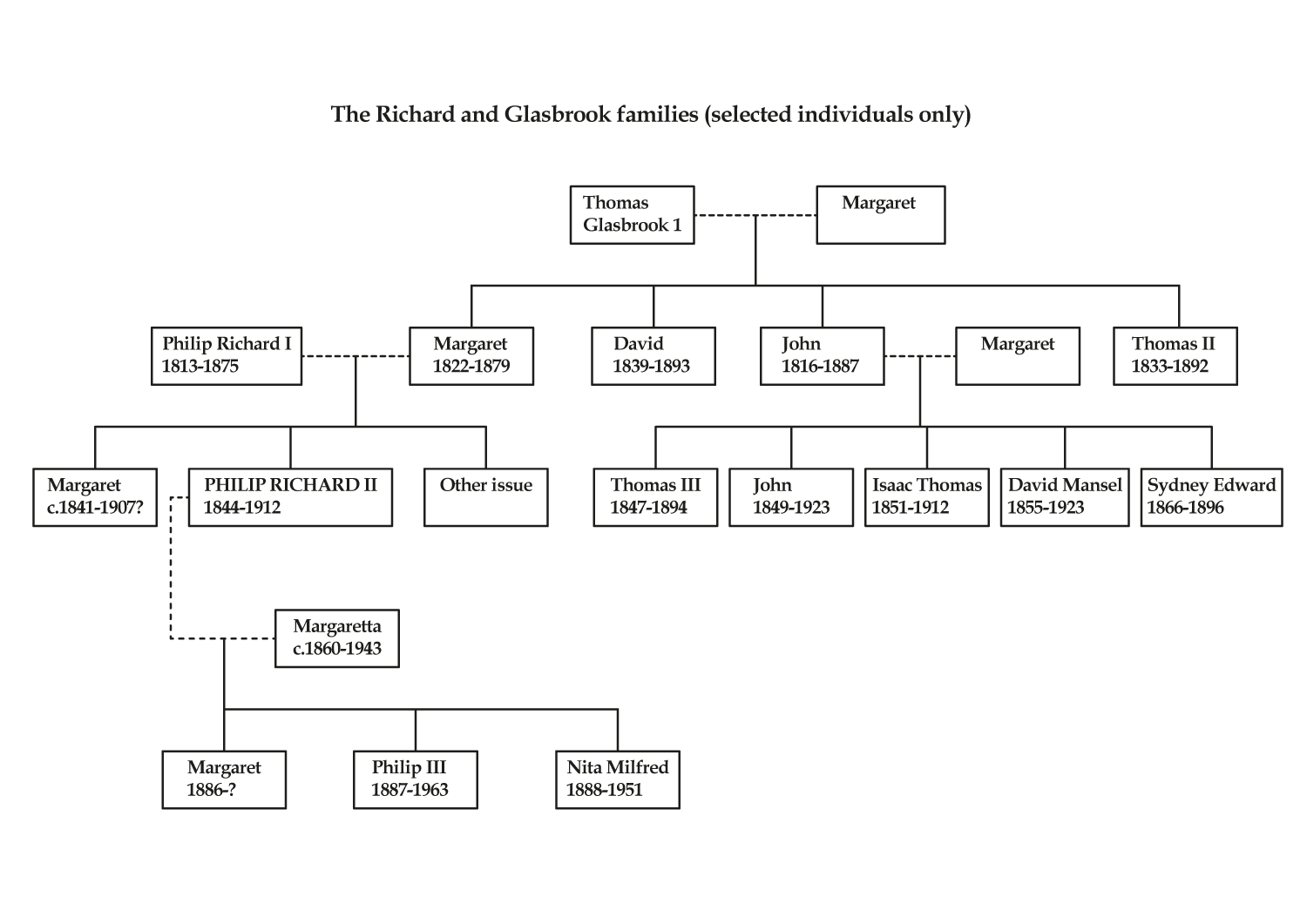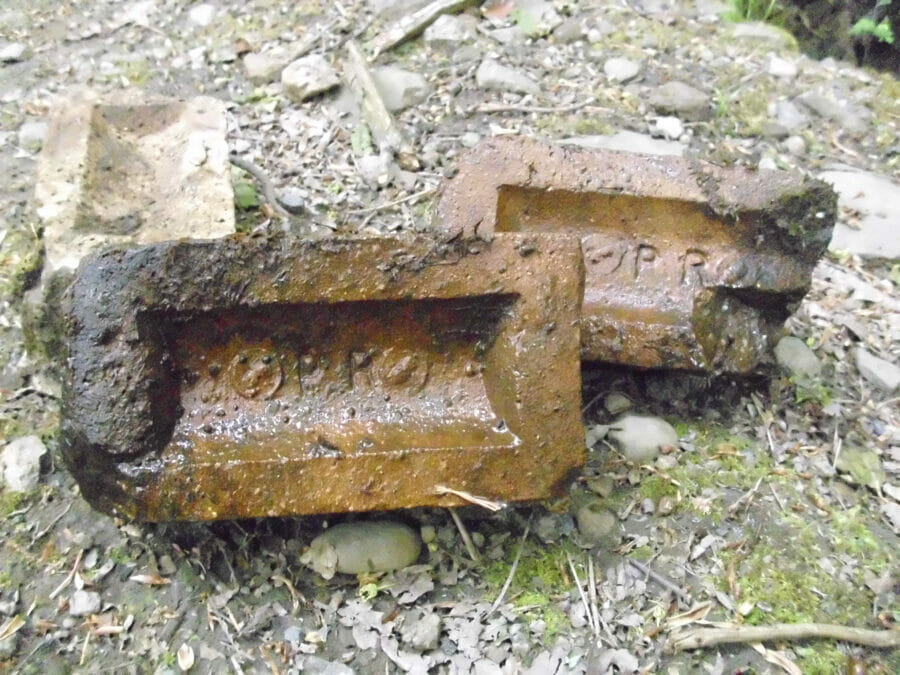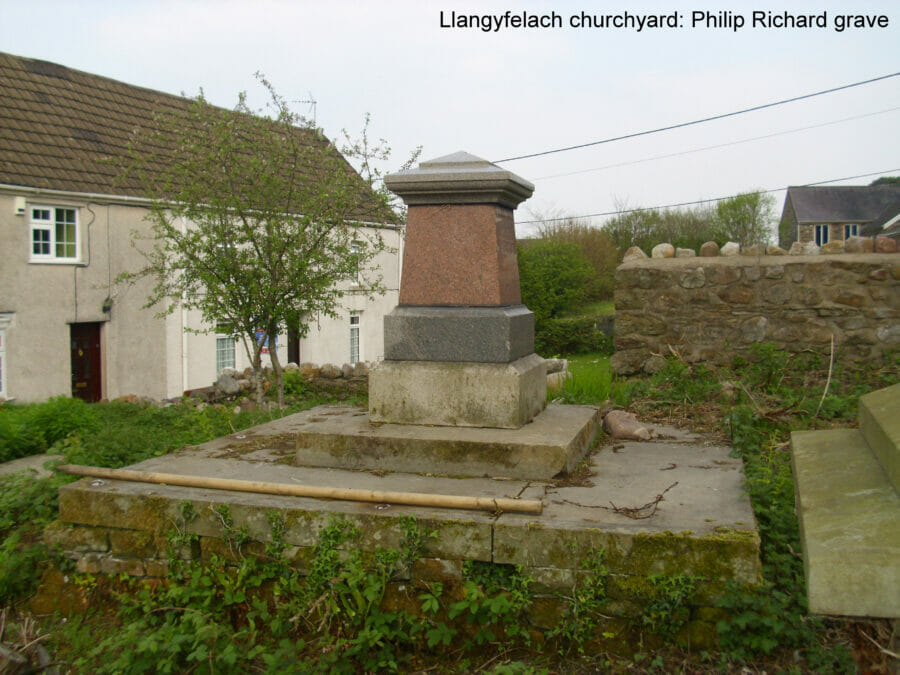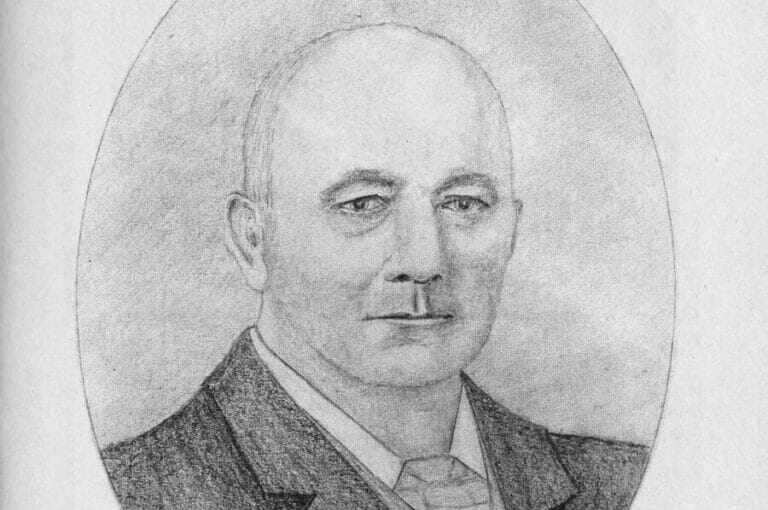Owner of Rhydydefaid and Commercial collieries

Philip Richard the younger was a prominent figure in the coal industry of 19th-century Swansea and in the affairs of the town in general. He belonged to a family that had many connections with the coal industry. His father, Philip Richard senior (1813–1876), was a land and mineral surveyor and also a coal owner. His uncle was John Glasbrook (1816–1887), probably the largest coal owner in mid-Victorian Swansea and a prominent figure in the municipal life of the town. Another uncle, Thomas Glasbrook (1833–1892), owned or managed several collieries in the Fforestfach area and was connected with the Landore Siemens Steel Company, and his five cousins formed the firm of Glasbrook Brothers who remained a major force in the local coal industry into the 20th century.
Philip Richard was born at the family home which was then Cockett Farm on 13 June 1844. He had an older sister, Margaret, and several younger siblings. Soon after PR’s birth his father, in partnership with John Glasbrook (his brother-in-law), started up in the mining trade. They leased Gorse and Weig Fawr collieries at Cockett in about 1846, Weig and Gendros about a year later. Subsequently, in 1854, when they had established themselves, they took a lease of the Duke of Beaufort’s coal in the lower Swansea valley. This was the area that had been worked intensively by three generations of the Morris family from 1732 until 1845, but there was still coal left to be got and the brothers-in-law opened (or re-opened) Cwm Pit, Copper Pit, Forest New Pit and Plas Marl.

Nothing is known of the childhood, education and early adulthood of PR. At the time of the 1851 census, the family was still at Cockett but by 1861 they had moved to Ravenhill. PR is described in both censuses as a ‘scholar’ (i.e. schoolboy). Their 1861 home is named ‘Ravenhill Cottage’ in the census returns but it was hardly a cottage. Rather, it was really the very comfortable Ravenhill House in the middle of what is now Ravenhill park. When it was offered for sale in 1881 it was described as ‘a most desirable freehold residential property … seated in tastefully disposed pleasure grounds and gardens’. On the ground floor, it contained a dining room, a drawing room, a morning room, a small conservatory, a portico entrance, a coach house, a kitchen, dairy, scullery and piggery. On the first floor there were four bedrooms and a dressing room and on the grounds, a large greenhouse, vinery, tennis lawn and a large kitchen garden. Nearby were stables, a coach house, another (?) piggery, a poultry house, a cow house and a stable for five horses. Even if nothing is known of PR’s early years, it is clear that they must have been very comfortable – and as his subsequent history will show, he grew accustomed to this style of living.
Rhydydefaid
After his formal education ceased, PR presumably worked in the family business and learnt the skills of a mining engineer under his father and uncle. By 1870 he was ready to go into business on his own and he took over the lease of Rhydydefaid colliery in the Clyne valley. The colliery had been sunk by George Byng Morris in the early 1840s and was subsequently worked without a great deal of success by a succession of short-lived companies and partnerships. The Rhydydefaid surface buildings lay on the Morris estate but the colliery also worked coal under the Beaufort estate on the opposite side of the river.
PR seems to have been successful at Rhydydefaid, although the pit suffered from the accidents and labour unrest that were an almost inevitable accompaniment of the mining industry. Coal was sent out both by both the London & North Western Railway and by the Oystermouth Railway. Rhydydefaid was connected to the LNWR by means of a siding that joined the mainline a little way south of Killay station and to the Oystermouth Railway by an extension to the original Clyne valley branch of 1804. G B Morris had built this extension in about 1841 when he started to open the colliery. PR introduced a steam locomotive on this privately owned line but its use was not confined to this section alone: it also continued to operate over the Clyne valley branch and the mainline of the Oystermouth Railway all the way to the New Cut where the Rhydydefaid colliery had its own wharf. The town’s gasworks also sourced a lot of its coal from Rhydydefaid at one time. The first mention of a locomotive is in the Cambrian in 1878 (21 June) in connection with the controversy surrounding the introduction of steam-hauled passenger trains on the Oystermouth line in 1877. The tone of the comment seems to suggest that the locomotives were already a familiar feature of the town:
PR’s locomotive got him into trouble in 1882 when he was up before the Police Court for using a locomotive on the Mumbles Railway that ‘did not consume its own smoke’. The case was dismissed but PR had to promise to do something to mitigate the nuisance. It is unfortunate that nothing more seems to be known of this locomotive.
In 1880 PR became a partner in the Gendros Coal Company which was formed that year by his uncle, Thomas Glasbrook. There is nothing to suggest that he took an active part in the affairs of the company but it may show that he had done well enough at Rhydydefaid during the past ten years to have built up some spare capital that he could afford to invest in his uncle’s venture.

PR continued to work Rhydydefaid although by now it was approaching the end of its economic life. It was abandoned in 1884 and the plant was then offered for sale in 1885. There was no mention of the locomotive so perhaps he decided to keep it for use at another colliery.
Dunvant and Fforestfach
To replace PR then transferred operations to Dunvant where he re-opened the Dunvant slant that had been started by Silvanus Padley in 1864 and worked by him until 1873. PR started operations here in 1884 and by 1891 he had added a brickworks; the bricks that were produced can be recognised by being stamped ‘P R’. He extended his taking in 1889 with a lease of coal under Brynllanerch (west of Hendrefoilan Road) and again in 1898 with a lease of coal under Voilart. Coal was mostly supplied to the local tinplate trade.

The colliery faced increasing difficulties after about 1900; the Glylid, Clement, Rock and Yankee seams were abandoned in February 1904 and the slant was closed. It was re-opened in August 1905 to work the Penclawdd seam but then it was finally closed after PR was declared bankrupt in February 1908.
Also in 1884 PR took on the management of Worcester and Weig Fach pits at Fforestfach. These had originally been opened by uncle Thomas Glasbrook in 1861 (Worcester) and 1870 (Weig Fach). Glasbrook subsequently sublet them to the Landore Siemens Steel Co and the Steel Company in turn sublet the working of the pits to a separate company. When this company surrendered in 1884 PR took over both collieries and formed the Forest Fach Coal Company to work them. Weig Fach was absorbed into Worcester in 1889 and the combined colliery finally closed in 1897, still in the hands of PR who by this time had become the primary lessee under the Duke of Beaufort.
Other interests
So by the mid-1880s PR had created a position for himself in the coal industry with interests at Gendros, Dunvant, Weig Fach and Worcester. He still held the Rhydydefaid lease and although he was not actively working it, he had plans to open up new areas of the coal in and around the Clyne valley.
At the same time, there were developments in his personal life. In 1881 he was still living in the family home with his widowed mother (PR senior had died in 1876) and with two unmarried sisters and an unmarried brother. In 1885 he married Margaretta (Greta) Williams from Llanelly who was about 15 years younger than him and set up a house on his own. Their first home was 89 Walter Road (at the end of Belgrave Terrace in the Uplands) and his three children, Margaret, Philip and Nita were all born there.
It was in 1888, while he was living at Belgrave Terrace, that PR suffered a serious accident. He was driving home from Dunvant in a trap when his horse took fright and bolted. He was thrown out and so badly injured that it was necessary to amputate one of his feet.
By 1891 he had moved up in the world – literally and metaphorically – and taken up residence in Hill House, a very grand Georgian gentry house, following the death in 1889 of its previous owner Iltid Thomas. It was perhaps at about this time, too, that he set up a dairy farm at Penplas. It would certainly be the sort of undertaking that would be consistent with the self-image of the landed gentleman that he was apparently trying to cultivate.
As became his newfound gentry status he also developed an active involvement in politics. He was among those who selected the Conservative candidate for Gower in the 1891 general election and in 1893 he entered local politics himself when he was elected a Conservative councillor for the Ffynone ward in Swansea. The following year he was additionally elected one of the Poor Law Guardians for the parish of Cockett.
Commercial Colliery
Meanwhile, PR was not neglecting his business interests. In 1888 he started to develop a replacement for the old Rhydydefaid colliery in the Clyne valley that had been closed a few years earlier. It was originally known as Rhydydefaid no 2 but the name was changed to Commercial in 1899, taken from the public house behind which it was located. Its workings lay beneath an area between Gower Road and Hendrefoilan Road. A long straight railway embankment was built through the woods to carry a siding from the LNWR main line; it still forms a prominent feature in the Clyne Valley Country Park. It seems that some at least of the coal sent out in this way was transferred to the Mumbles Railway by means of the exchange sidings at Mumbles Road.
Production probably started in April 1891 in the Glylid seam. Between 1891 and 1894 the Wernddu, Wernpistyll and Rock seams were also brought into production but worked only to a limited extent because of problems caused by an unexpected dip in the seams which made it difficult to work the colliery economically. Work was suspended in 1895; it was resumed in 1896 but again only on a small scale. In 1897 a connection in the Glylid seam was made with PR’s Dunvant slant but by 1899 the colliery was once again idle.
In 1896 Richard started to explore the coal under Llanerch and Olchfa (41 acres) which lay between Dunvant Road and Hendrefoilan Road and adjoined his existing taking. His findings were promising and in 1898 he took a lease of the coal. This gave him access to an area of more easily worked coal in the Penclawdd seam which made the colliery a more viable proposition. Work started again in 1899 and carried on until 1907 but, as will be seen, with increasing difficulty.
Weig Fawr
In 1892 PR took a lease from the Calvert Richard Jones estate of coal under Weig Fawr which lay on the north side of Mayhill. It was an area where his father and John Glasbrook had worked in the 1840s and 1850s until flooding made them give it up. PR started to re-open and pump out the pit that had been sunk by his father and uncle. Coal finally started to be produced in 1898.
However (a big ‘however’) Weig Fawr pit lay very close to the tunnel that carried the Great Western Railway’s mainline between Swansea and Llanelli and PR’s pumping operations resulted in the ground beneath the tunnel settling. This led to cracks appearing within the tunnel and the GWR had been carrying out a programme of repairs since 1893. Then, on 26 March 1899 Weig Fawr was inundated by a flood of water from the old workings. The water rose to within 54 yards of the surface (i.e. about halfway up the shaft). PR started to pump out the water and by the middle of June the shaft was clear and the colliery was once again workable, but the process of dewatering resulted in the ground underlying the railway tunnel becoming seriously destabilised and on 19 June a collapse of part of the tunnel roof took place.
The details of the tunnel collapse and how the GWR maintained their services is another story. Enough to say that normal working was restored in due course but there remained unfinished business between Richard and the GWR. In 1900 the GWR introduced a bill into Parliament that, among other things, sought to prevent coal working within 110 yards on either side of the Cockett tunnel (instead of 40 yards which was the normal exclusion zone). Richard naturally lodged a formal objection but lost.
He followed this up in 1901 with a claim against GWR for £30,000 as compensation for his losses in not being able to work this large area of coal. The case went to arbitration and eventually (February 1902) he was awarded just £12,000. He appealed, but without success, and altogether the case had cost him a great deal of money.
The conclusion
In February 1908 PR was declared bankrupt. All sorts of problems emerged at his examination the following month:
- he had gross liabilities of £56,094 and a deficiency of £27,380
- his trading loss since 1903 was £26,239
- he had lost about £20,000 at Worcester colliery before it closed in 1897
- he had spent £30,000 on Weig Fawr and it was still running at a loss. He had foolishly signed a lease which didn’t allow him to surrender unless the mine proved unworkable
- At Dunvant and Commercial he had difficulties in recruiting good workmen. The equipment at these collieries was old, inefficient and expensive. The colliery boilers consumed 20% of the output and he couldn’t afford to replace them
Altogether the picture emerged of a picture of a man who had seriously over-reached himself and was living beyond his means.
All the plant and machinery at his collieries was sold under distress but obviously cannot have raised very much. He was naturally forced to leave Hill House and in 1911 the family was living at a house called Glanmor in Blackpill/West Cross. The brickworks was in the name of his son, so at least that was saved and in the census returns for 1911 PR described himself as ‘Secretary of works’ with his son, Philip III described as ‘Manager of brickworks’. PR did not survive much longer. He died on 9 April 1912. By this date, he had moved from Blackpill to a house called Pantysifi (on Gower Road, just uphill from Sketty Cross, formerly occupied by the vicar of Sketty). He was buried in Llangyfelach churchyard, almost certainly under the ostentatious monument that had been erected for his father. His name does not appear on this memorial but there can be little doubt that in setting it up PR intended it to be a family mausoleum.

